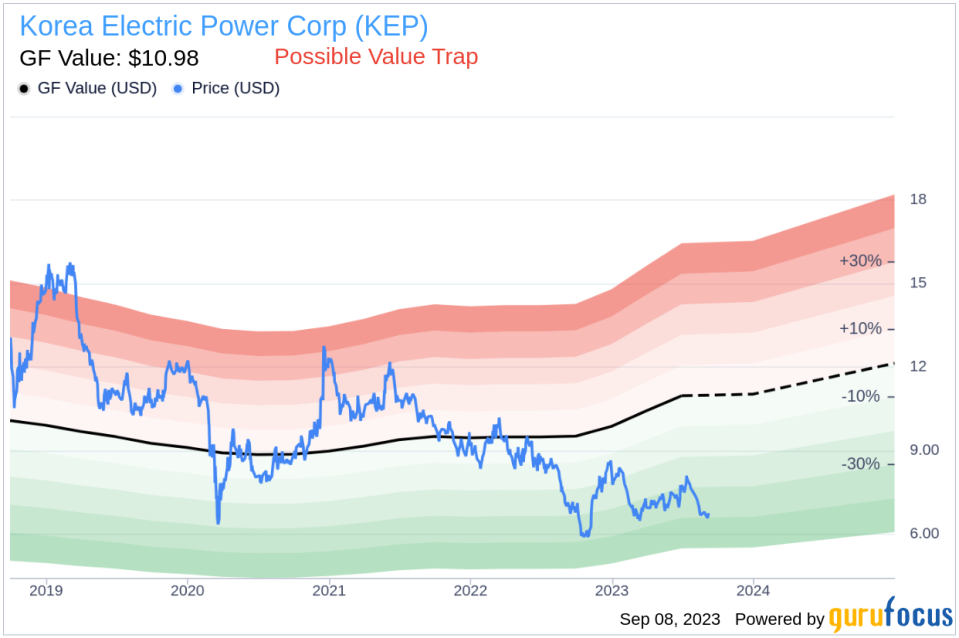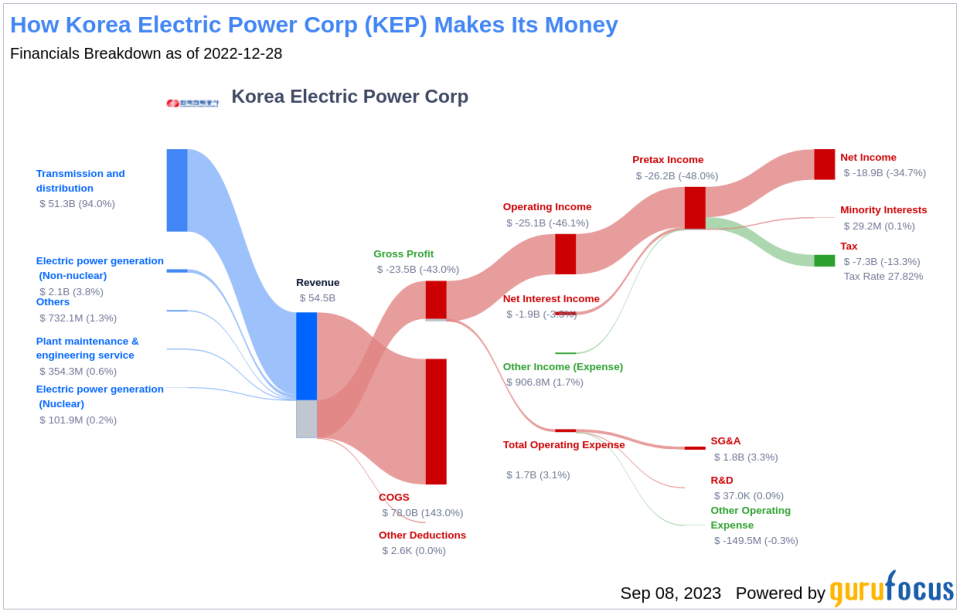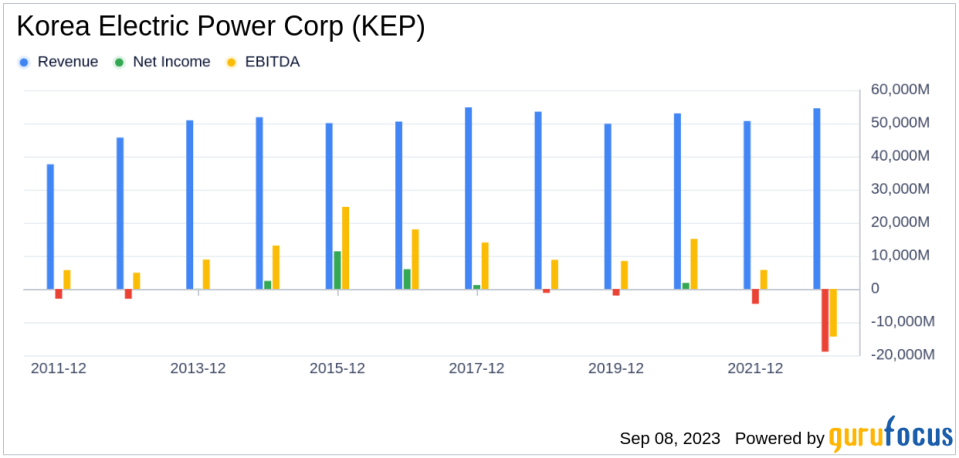Is Korea Electric Power (KEP) Too Good to Be True? A Comprehensive Analysis of a Potential ...
Value-focused investors are constantly seeking stocks that are priced below their intrinsic value. One such stock that deserves attention is Korea Electric Power Corp (NYSE:KEP). Currently priced at 6.75, the stock recorded a gain of 4.01% in a day and a 3-month decrease of 10.94%. The fair valuation of the stock, according to its GF Value, is $10.98.
Understanding the GF Value
The GF Value represents the current intrinsic value of a stock derived from our exclusive method. The GF Value Line on our summary page provides an overview of the fair value at which the stock should be traded. This value is calculated based on historical multiples that the stock has traded at, the GuruFocus adjustment factor based on the company's past returns and growth, and future estimates of business performance. If the stock price is significantly above the GF Value Line, it is overvalued and its future return is likely to be poor. Conversely, if it is significantly below the GF Value Line, its future return will likely be higher.
However, investors should consider a more in-depth analysis before making an investment decision. Despite its seemingly attractive valuation, certain risk factors associated with Korea Electric Power should not be overlooked. These risks are primarily reflected through its low Altman Z-score of 0.03, and a Beneish M-Score of 0.9 that exceeds -1.78, the threshold for potential earnings manipulation. These indicators suggest that Korea Electric Power, despite its apparent undervaluation, might be a potential value trap. This complexity underlines the importance of thorough due diligence in investment decision-making.
Demystifying the Altman Z-Score and Beneish M-Score
The Altman Z-score, invented by New York University Professor Edward I. Altman in 1968, is a financial model that predicts the probability of a company entering bankruptcy within a two-year time frame. The Z-Score combines five different financial ratios, each weighted to create a final score. A score below 1.8 suggests a high likelihood of financial distress, while a score above 3 indicates a low risk.
The Beneish M-Score, developed by Professor Messod Beneish, is based on eight financial variables that reflect different aspects of a company's financial performance and position. These variables include Days Sales Outstanding (DSO), Gross Margin (GM), Total Long-term Assets Less Property, Plant and Equipment over Total Assets (TATA), change in Revenue (?REV), change in Depreciation and Amortization (?DA), change in Selling, General and Admin expenses (?SGA), change in Debt-to-Asset Ratio (?LVG), and Net Income Less Non-Operating Income and Cash Flow from Operations over Total Assets (?NOATA).
Company Snapshot: Korea Electric Power Corp (NYSE:KEP)
Korea Electric Power Corp is an electric utility company in which the government of South Korea holds a controlling stake. The firm operates in the following segments: Transmission and distribution, Electric power generation (Nuclear), Electric power generation (Non-Nuclear), Plant maintenance & engineering service, and Others. Most of the energy produced by the company comes from its nuclear and coal-fired assets. Korea Electric Power generates revenue primarily through the Transmission and distribution segment. The company's stock price and the GF Value provide a comparative measure of its fair value, paving the way for a more profound exploration of the company's value.
Korea Electric Power's Low Altman Z-Score: A Breakdown of Key Drivers
The Retained Earnings to Total Assets ratio provides insights into a company's capability to reinvest its profits or manage debt. Evaluating Korea Electric Power's historical data, 2021: 0.24; 2022: 0.16; 2023: 0.07, we observe a declining trend in this ratio. This downward movement indicates Korea Electric Power's diminishing ability to reinvest in its business or effectively manage its debt. Consequently, it exerts a negative impact on its Z-Score.
The EBIT to Total Assets ratio serves as a crucial barometer of a company's operational effectiveness, correlating earnings before interest and taxes (EBIT) to total assets. An analysis of Korea Electric Power's EBIT to Total Assets ratio from historical data (2021: 0.02; 2022: -0.09; 2023: -0.10) indicates a descending trend. This reduction suggests that Korea Electric Power might not be utilizing its assets to their full potential to generate operational profits, which could be negatively affecting the company's overall Z-score.
The Gross Margin index tracks the evolution of a company's gross profit as a proportion of its revenue. A downward trend could indicate issues such as overproduction or more generous credit terms, both of which are potential red flags for earnings manipulation. By examining the past three years of Korea Electric Power's historical data (2021: 8.66; 2022: -27.49; 2023: -3.63), we find that its Gross Margin has contracted by 7.89%. Such a contraction in the gross margin can negatively impact the company's profitability as it signifies lesser income from each dollar of sales. This could put a strain on the company's capacity to manage operating costs, potentially undermining its financial stability.
The asset quality ratio, calculated as Total Long-term Assets minus Property, Plant, and Equipment, divided by Total Assets, gauges the proportion of intangible or less tangible assets within a company's asset structure. Analyzing Korea Electric Power's asset quality ratio over the past three years (2021: 0.07; 2022: 0.10; 2023: 0.13), an increase might signal underlying issues, such as capitalizing normal operating expenses or goodwill impairment. These factors can inflate assets and mask true operational costs, potentially misrepresenting the company's actual financial position, and raising concerns for investors about its true value and risk profile.
Conclusion
Despite its seemingly attractive valuation, the financial indicators suggest that Korea Electric Power, with its low Altman Z-Score and high Beneish M-Score, might be a potential value trap. This highlights the importance of thorough due diligence and a comprehensive analysis of a company's financial health before making an investment decision. Thus, while Korea Electric Power may initially appear as a promising investment opportunity, the underlying risks and financial instability indicate that it could indeed be a value trap.
GuruFocus Premium members can find stocks with high Altman Z-Score using the following Screener: Walter Schloss Screen . To find out the high-quality companies that may deliver above-average returns, please check out GuruFocus High Quality Low Capex Screener.
This article first appeared on GuruFocus.



